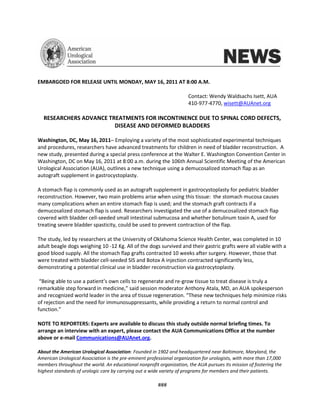
5.16.11.reconstructive urology
- 1. EMBARGOED FOR RELEASE UNTIL MONDAY, MAY 16, 2011 AT 8:00 A.M. Contact: Wendy Waldsachs Isett, AUA 410-977-4770, wisett@AUAnet.org RESEARCHERS ADVANCE TREATMENTS FOR INCONTINENCE DUE TO SPINAL CORD DEFECTS, DISEASE AND DEFORMED BLADDERS Washington, DC, May 16, 2011– Employing a variety of the most sophisticated experimental techniques and procedures, researchers have advanced treatments for children in need of bladder reconstruction. A new study, presented during a special press conference at the Walter E. Washington Convention Center in Washington, DC on May 16, 2011 at 8:00 a.m. during the 106th Annual Scientific Meeting of the American Urological Association (AUA), outlines a new technique using a demucosalized stomach flap as an autograft supplement in gastrocystoplasty. A stomach flap is commonly used as an autograft supplement in gastrocystoplasty for pediatric bladder reconstruction. However, two main problems arise when using this tissue: the stomach mucosa causes many complications when an entire stomach flap is used; and the stomach graft contracts if a demucosalized stomach flap is used. Researchers investigated the use of a demucosalized stomach flap covered with bladder cell-seeded small intestinal submucosa and whether botulinum toxin A, used for treating severe bladder spasticity, could be used to prevent contraction of the flap. The study, led by researchers at the University of Oklahoma Science Health Center, was completed in 10 adult beagle dogs weighing 10 -12 Kg. All of the dogs survived and their gastric grafts were all viable with a good blood supply. All the stomach flap grafts contracted 10 weeks after surgery. However, those that were treated with bladder cell-seeded SIS and Botox A injection contracted significantly less, demonstrating a potential clinical use in bladder reconstruction via gastrocytoplasty. “Being able to use a patient’s own cells to regenerate and re-grow tissue to treat disease is truly a remarkable step forward in medicine,” said session moderator Anthony Atala, MD, an AUA spokesperson and recognized world leader in the area of tissue regeneration. “These new techniques help minimize risks of rejection and the need for immunosuppressants, while providing a return to normal control and function.” NOTE TO REPORTERS: Experts are available to discuss this study outside normal briefing times. To arrange an interview with an expert, please contact the AUA Communications Office at the number above or e-mail Communications@AUAnet.org. About the American Urological Association: Founded in 1902 and headquartered near Baltimore, Maryland, the American Urological Association is the pre-eminent professional organization for urologists, with more than 17,000 members throughout the world. An educational nonprofit organization, the AUA pursues its mission of fostering the highest standards of urologic care by carrying out a wide variety of programs for members and their patients. ###
- 2. 1189 RE-EPITHELIZATION OF A DEMUCOSALIZED STOMACH PATCH WITH UROTHELIAL CELLS SEEDED SMALL INTESTINE SUBMUCOSA IN BLADDER AUGMENTATION Yuanyuan Zhang, GuiHua Liu, Kropp BP, Winston-Salem, NC INTRODUCTION AND OBJECTIVES: A pedicle stomach flap is commonly used as an autograft supplement in gastrocystoplasty for pediatric bladder reconstruction. However, two main problems arise when using stomach flaps: 1). the stomach mucosa causes many complications when an entire stomach flap is used and 2) the stomach graft contracts if a demucosalized stomach flap is used. Botulium Toxin A (Botox A) is widely used for treating severe bladder spasticity. This study is designed to evaluate the possibility of using a demucosalized stomach flap covered with bladder cell-seeded small intestinal submucosa (SIS) for gastrocystoplasty and to determine whether an injection of Botox A into the re-urothelized stomach flap could protect the graft from contraction in a canine bladder reconstruction model. METHODS: Ten adult beagle dogs weighing from 10-12 Kg were used. The animals were divided into five groups. Gastrocystoplasty was performed using entire stomach flaps as a control (n=2, Group I). The other groups consisted of animals repaired with demucosalized stomach flaps alone (n=2, Group II), demucosalized flaps covered with unseeded SIS (n=2, Group III), demucosalized flaps covered with bladder cell (urothelial and smooth muscle cells) seeded SIS (n=2, Group IV) and demucosalized flaps with bladder cell-seeded SIS combined with an injection of Botox A (10 units /ml, 50 units) (n=2, Group V). The graft tissue samples were examined histologically and with immunohistochemistry ten weeks after gastrocystoplasty. RESULTS: All dogs survived and their gastric grafts were all viable with a good blood supply. Urothelium (metaplasia) appeared on the top of the stomach mucosa flaps in two animals in Group I. A calicification at the center of one graft was found in an animal in Group II. The stomach flaps were partially covered with urothelium in Groups II and III, and stratified urothelium completely covered the de-mucosalized gastric flaps in Groups IV and V. Although all stomach flap grafts contracted ten weeks after surgery, the stomach grafts in Groups I and V showed less contraction (half the original size). In contrast, the stomach grafts in Groups II, III, and IV significantly contracted to one quarter of the original size. CONCLUSIONS: Bladder cell-seeded SIS promotes complete urothelial regeneration on demucosalized stomach flap grafts. Botox A injection appears to protect the graft from contraction. Combination both of these techniques has a potential clinical use in bladder reconstruction via gastrocystoplasty. Source of Funding: none
